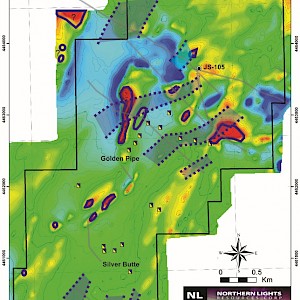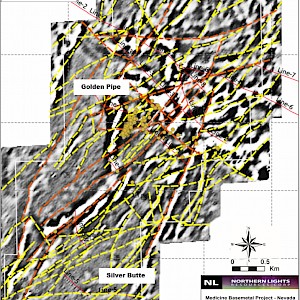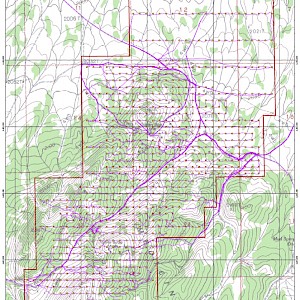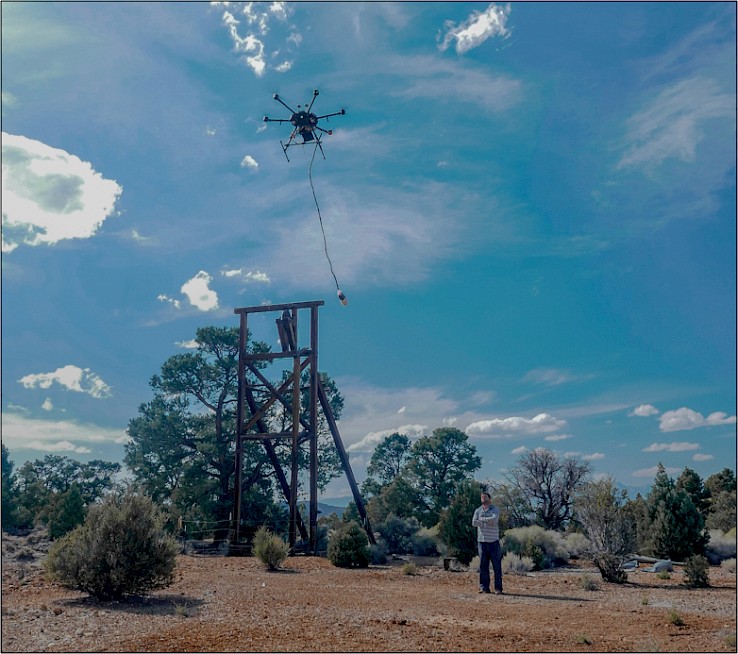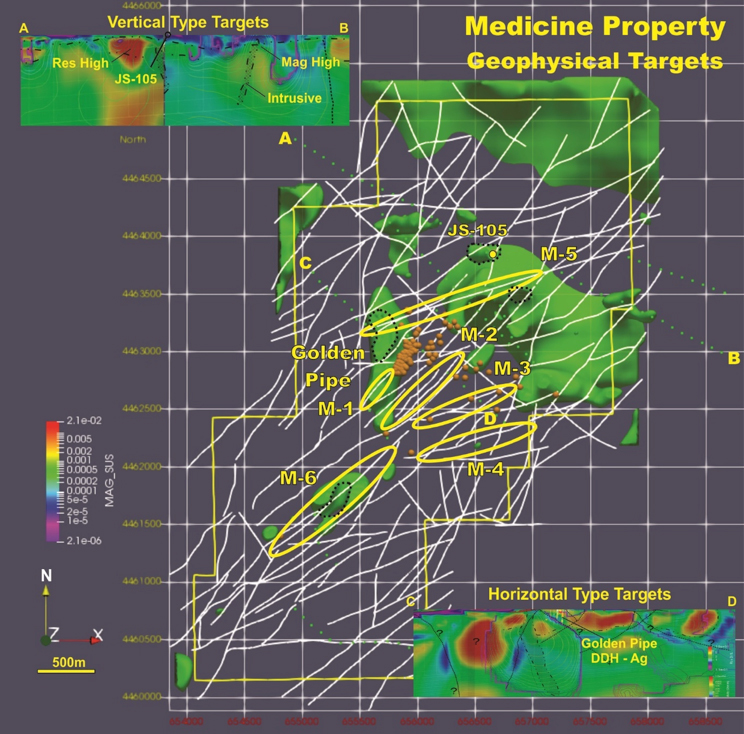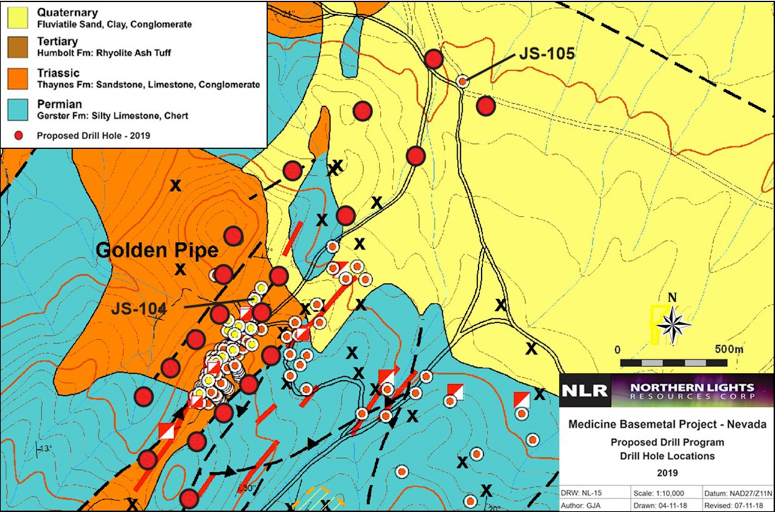Projects
Medicine Springs Project
Exploration Program
The intended exploration program for the Medicine Springs property comprised two phases.
Phase 1 Program was recently completed and included the preparation of NI43-101 report, the development of GIS data compilation, the completion of geophysical work and interpretation of the Aeromagnetic and CSAMT survey results, detailed geological mapping and surface sampling and the completion of a property wide soil sampling survey.
Phase 2 Program will include a targeted drill program focused on further delineation of the Golden Pipe oxide mineralization zone and the identification sulfide replacement style mineralization developed below the oxide zone at a depth below 150 meters.
Details of Phase 1 Exploration Program
Since acquiring the property rights to the Medicine Springs Project in August 2017, Northern Lights has completed the Phase 1 exploration program which was reported in Sedar on December 07, 2018 and February 01, 2019 The results and important conclusions are briefly summarized below.
A- NI43-101 Technical Report
A detailed NI43-101 Technical Report titled “Geological Report and Summary of Field Examination, Medicine Springs Property, Elko County, Nevada” dated January 15, 2018 has been filed on SEDAR (the “NI43-101 Report”). The NI43-101 Report was completed by independent geologist and qualified person, Robert Lunceford CPG, M.Sc.
The NI43-101 Report provides a comprehensive overview of past known exploration activities on the Project and a detailed discussion of potential analogue models for the Medicine Springs Project.
The NI43-101 Report suggests two geological models are applicable to the Property. The first is high-angle, structurally controlled silver and base metal mineralization hosted by and associated with jasperoids, breccia, and mineralized replacement of the Permian and Triassic carbonate units. Peripheral to these high-angle structures, the drilling documents a replacement-style mineralization developed within receptive carbonate beds. This combination of structural and stratigraphic control is typical for many precious metal deposits in Nevada including the carbonate replacement type mineralization. These deposit types are also characterized by zoning and significant vertical extent in contrast to limited depth of epithermal deposits.
The NI43-101 Report goes on to suggest that the Medicine Springs Property mineralization has geological similarities to the Hermosa/Taylor Zn-Pb-Ag deposit owned by South32 following the acquisition of all the issued equity in Arizona Mining Inc. in August 2018.
B- Development GIS Database
Northern Lights has compiled all historic exploration work including drill hole data and assays, surface sample assays, geophysics and geological mapping into GIS data base.
Northern Lights completed detailed surface mapping at a scale of 1:5,000 and rock sampling over the entire Medicine Springs license area. The mapping was carried out from August to November, 2108.
C- Aeromagnetic Survey
Northern Lights has completed an drone assisted aeromagnetic survey over the entire license area. A total of 810 line-kilometers was flown over the licence area at a nominal line spacing of 50 meters and a flying height of 30 meters. The survey has highlighted 6 geophysical targets that Northern Lights is planning to drilled in 2019. See Geophysics Results – Identify Key Targets below.
D- Cominco CSAMT Geophysical Data
In 1997-1998, Cominco American Inc. carried out Controlled Source Audio-frequency Magnetotellurics (CSAMT) and Induced Polarization (IP) geophysical surveys over the Medicine Springs Property. Cominco completed nine lines of CSAMT and a single line of IP. Recently Zonge Australia completed a 2D inversion of the Cominco CSAMT data.
E- Geophysical Interpretation Aeromagnetics and CSAMT Data
The aeromagnetic and CSAMT survey data were analyzed and interpreted by GeoExplore Pty Ltd, an Australian based geophysical consulting firm and the main conclusion are summarized below.
- Mineralization has an unclear geophysical signature.
- Six geophysical targets labeled M-1 to M-6 were identified based on magnetic structural analysis, proximity to interpreted intrusive dykes and an association with CSAMT resistivity highs.
- Geophysical targets include, i) horizontal carbonate replacement targets and ii) vertical targets associated with intrusive dykes.
- Magnetic structural targets M-2, 3 and 5 are coincident with strong resistivity highs and are considered to be priority drill targets in the Golden Pipe area, M-6 anomaly is also associated with anomalous soil Pb and Zn values
F- Ionic Leach Geochemical Soil Survey
Northern Lights completed a soil sampling survey over the entire licence area. The soil grid over 70% of the licence was completed on 100 x 100 meters and remainder of the area was covered by a 100 x 400 meter grid. A total of 794 samples were collected and have been submitted for analysis to ALS in Vancouver using a 62-element Ionic Leach analytical method.
Ionic Leach analysis is a cost-effective geochemical program for detecting subtle, coherent multi-element anomalies in surface soils associated with buried mineralized systems. Multi-element ion anomalies are characterized by a concise fingerprint developed directly above targets and can be effectively used to define concealed drilling targets.
Geophysics Results – Identify Key Targets
The results of both the CSAMT/IP and Aeromagnetic surveys were reviewed and interpreted by GeoExplore Pty Ltd, an Australian based geophysical consulting firm.
The geophysical survey results have identified six key targets with potential for mineralization based on structure and proximity to interpreted intrusive dykes. Some of these targets lie at an approximate depth range of several hundred meters from surface. The geophysical targets comprise 2 types, flat lying carbonate replacement targets and sub-vertical target associated with intrusive dykes.
The identified target zones include:
M-1 is the SSW extension of the Golden Pipe trend in an area that lacks drilling.
M-2 lies immediately east of the Golden Pipe trend and from a structural perspective have many analogues with Golden Pipe. The southern half of M-2 is coincident with a strong Pb-Zn soil anomaly identified by USMX in the 1980s.
M-3 follows a fault which has an ENE-WSW orientation, and which has already attracted several historical very shallow drill holes.
M-4 is a parallel structure which does not appear to have attracted past attention.
M-5 is the structure identified in the CSAMT which crosses a line between the Golden Pipe trend and drill hole JS-105.
M-6 covers a structure parallel to the Golden Pipe trend which is associated with magnetic zones, interpreted as intrusive dykes. The identified geophysical targets, historical drill holes locations and interpreted intrusive dykes are illustrated on Figure 9
Figure 9: Geophysical Targets M-1 t M-6. 3D model showing magnetic interpreted structures, drill hole collars (orange), CSAMT lines (dotted green line) and interpreted intrusive dykes (dashed black line) overlain on an isosurfaces of 0.00075 SI.
Medicine Springs – Phase 2 Exploration Program
The results of the Phase 1 Exploration Program will be used to enhance the understanding of the mineralization system at Medicine Springs and to serve as guidance for a comprehensive drill program in 2019.
The goals of the Phase 2 Exploration Program include further delineation of the oxide mineralization zone and the identification of sulfide carbonate replacement style mineralization at depth below the oxide zone.
It is estimated that a 3,000 to 5,000 meter drill program will test the two target types. The program will comprise 20-23 mostly vertical with some angle drill holes ranging in depth from 150 to 500 meters and covering a strike length of approximately 1,500 meters.

